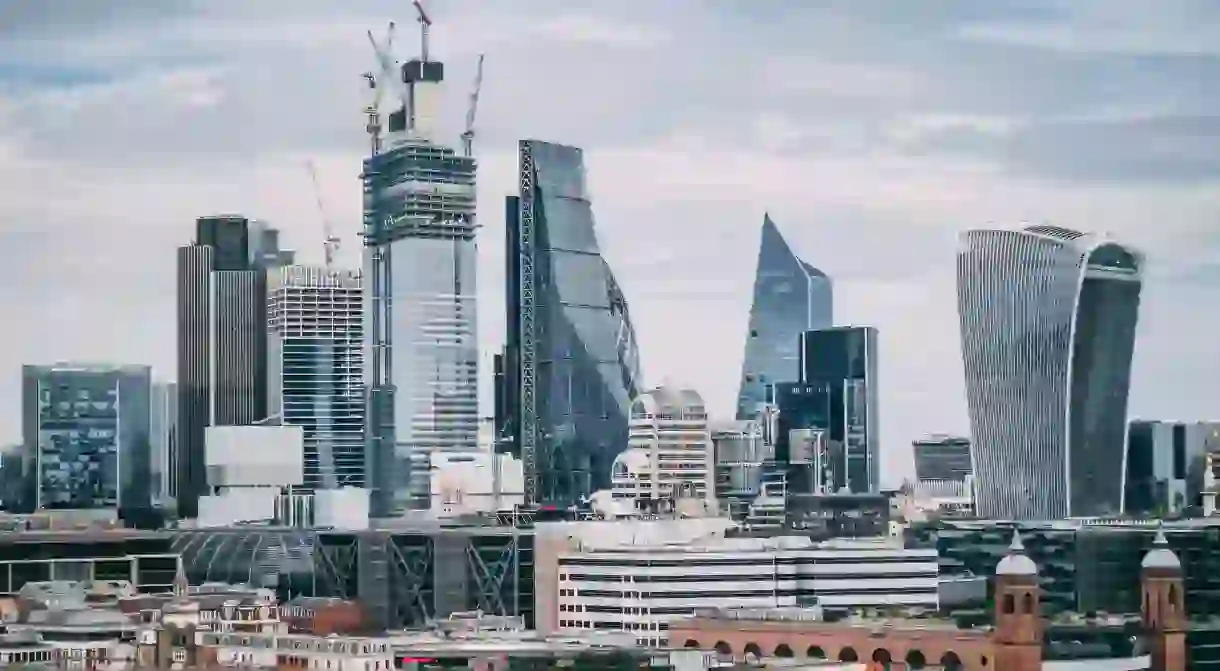A Guide to the City of London

London’s oldest neighbourhood hugs the Thames as the river turns east again after its northward glide past the Houses of Parliament and the London Eye. Here, in the City of London, skyscrapers loom over medieval streets, and historic icons such St Paul’s Cathedral and the Tower of London speak to the area’s powerful past.
The City, or the Square Mile, is the original London. Its walls, still visible today, were built by the Romans in AD 200 and marked its official boundaries until the end of the Middle Ages. As London’s historic financial district, it’s home to the imposing Bank of England and the Royal Exchange, as well as various newer developments that have sprung up in recent years.
The changing face of London
The introduction of 21st-century skyscrapers (commonly known by their affectionate nicknames) has added to an instantly recognisable skyline that was once dominated by the dome of St Paul’s Cathedral alone. Even though the Gherkin, Walkie Talkie and Cheesegrater are in stark contrast to their architectural predecessors, they fall in line with City tradition – the last of the three got its distinctive shape because of its proximity to one of eight “protected view corridors”, pathways enshrined in law that guarantee uninterrupted views of the cathedral from points across London.

For views of the City and right across the capital, head to the Sky Garden on the top floor of the Walkie Talkie or climb the 311 steps to the tip of the Monument, a column erected to commemorate the Great Fire of London, which ravaged London in 1666, and to celebrate the city’s rebuilding.
Where to stay in the City of London
When Londoners refer to ‘The City’, this is the part of town they mean. Traditionally this is an area you would work in – particularly if you were in financial services – or visit as a tourist. You’ll still find crowds gathering around some of the popular attractions here but its never been a place you would actually stay in. Homes are in short supply, with everyone commuting in from further afield, but there are a number of hotels popping up now.

The Westin London City boasts an impressive riverside location and spectacular views over the River Thames. Overlooking Shakespeare’s Globe and the striking Tate Modern, the luxury spa hotel offers 222 guest rooms, suites and four Residences impeccably designed with the Westin Heavenly Bed, sleek bathrooms, and free high-speed Wi-Fi. Guests are invited to indulge in an array of Westin services and amenities. Experience Hithe + Seek, a stunning bar with panoramic London views, and Mosaic, a convivial all-day dining restaurant.
The hotel opened in 2021 and has a unique architecture which converts the Brutalist exterior with sumptuous interiors. The property straddles a main thoroughfare through the area with scenic views available at the restaurant. On the other side you can see across the river to the South Bank, and area which has also undergone a recent programme of renovation including the emergence of The Shard.

The hotel has a uniquely historic location on Queenhithe, with historical references including remnants of the Huggin Hill Roman public bathhouse from the first century AD. Queenhithe Dock is the only remaining Anglo-Saxon dock in the world, and it has been commemorated with a 30-meter-long mosaic showcasing its remarkable layers of history, from Roman times to the present. There are many hidden gems from Roman times including at the hotel’s Heavenly Spa by Westin, where they discovered archaeological remains of the Huggin Hill Roman public bathhouse from the first century AD.
More of the City
As new development has continued, glimpses into the area’s past have revealed themselves piece by piece. Beneath the cobbled streets lies the Billingsgate Roman Bathhouse and below Bloomberg’s European headquarters sits the Roman Temple of Mithras. First discovered under rubble during the Blitz, it can be viewed today as part of an incredible immersive exhibition. The reconstructed temple is home to a number of Roman artefacts found during its excavation, which are presented alongside new art commissions.
But you don’t have to go underground to go back in time. When Leadenhall Market was first built nearly 2,000 years ago it was the largest market north of the Alps, and it has long been a bustling trading spot. No longer used for the trade of meat and poultry, as it was in the 14th century, it’s now home to shops, bars and restaurants – extensive refurbishment in the 1990s preserved its glorious Victorian roof, cobbles and framework.

Alternatively, make you way to Guildhall to see the largest surviving medieval crypts in London, which are housed within its Gothic grandeur. Fans of 20th-century architecture should walk to the Barbican for some of the best examples of the Brutalism that flourished in the 1960s and ’70s, as well as for the concerts and exhibitions shown within its hand-drilled concrete walls.

For a more gruesome view of the City, walking tours exploring the Plague, Jack the Ripper and even the area’s ghosts are easy to find, and there are plenty of brilliant watering holes along the way – Ye Olde Cheshire Cheese and the Rising Sun are particularly special.
Original article by Luke Bradshaw













